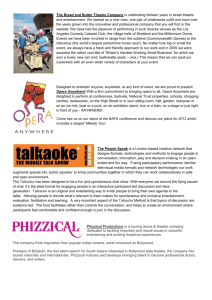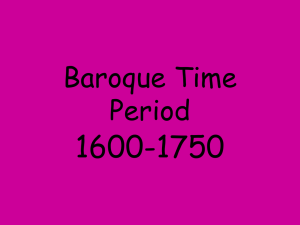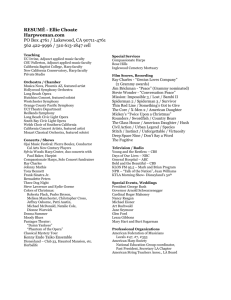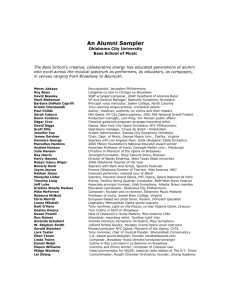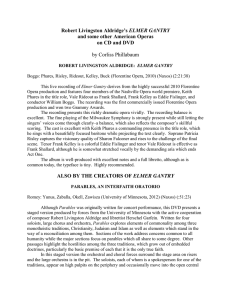Document
advertisement
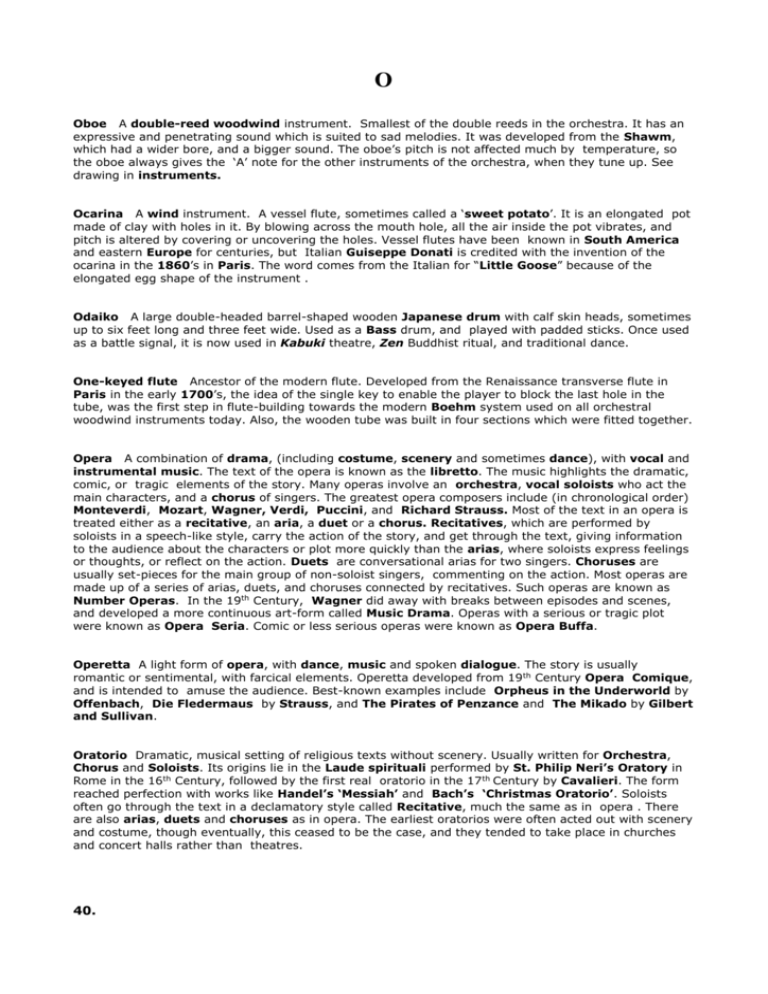
O Oboe A double-reed woodwind instrument. Smallest of the double reeds in the orchestra. It has an expressive and penetrating sound which is suited to sad melodies. It was developed from the Shawm, which had a wider bore, and a bigger sound. The oboe’s pitch is not affected much by temperature, so the oboe always gives the ‘A’ note for the other instruments of the orchestra, when they tune up. See drawing in instruments. Ocarina A wind instrument. A vessel flute, sometimes called a ‘sweet potato’. It is an elongated pot made of clay with holes in it. By blowing across the mouth hole, all the air inside the pot vibrates, and pitch is altered by covering or uncovering the holes. Vessel flutes have been known in South America and eastern Europe for centuries, but Italian Guiseppe Donati is credited with the invention of the ocarina in the 1860’s in Paris. The word comes from the Italian for “Little Goose” because of the elongated egg shape of the instrument . Odaiko A large double-headed barrel-shaped wooden Japanese drum with calf skin heads, sometimes up to six feet long and three feet wide. Used as a Bass drum, and played with padded sticks. Once used as a battle signal, it is now used in Kabuki theatre, Zen Buddhist ritual, and traditional dance. One-keyed flute Ancestor of the modern flute. Developed from the Renaissance transverse flute in Paris in the early 1700’s, the idea of the single key to enable the player to block the last hole in the tube, was the first step in flute-building towards the modern Boehm system used on all orchestral woodwind instruments today. Also, the wooden tube was built in four sections which were fitted together. Opera A combination of drama, (including costume, scenery and sometimes dance), with vocal and instrumental music. The text of the opera is known as the libretto. The music highlights the dramatic, comic, or tragic elements of the story. Many operas involve an orchestra, vocal soloists who act the main characters, and a chorus of singers. The greatest opera composers include (in chronological order) Monteverdi, Mozart, Wagner, Verdi, Puccini, and Richard Strauss. Most of the text in an opera is treated either as a recitative, an aria, a duet or a chorus. Recitatives, which are performed by soloists in a speech-like style, carry the action of the story, and get through the text, giving information to the audience about the characters or plot more quickly than the arias, where soloists express feelings or thoughts, or reflect on the action. Duets are conversational arias for two singers. Choruses are usually set-pieces for the main group of non-soloist singers, commenting on the action. Most operas are made up of a series of arias, duets, and choruses connected by recitatives. Such operas are known as Number Operas. In the 19th Century, Wagner did away with breaks between episodes and scenes, and developed a more continuous art-form called Music Drama. Operas with a serious or tragic plot were known as Opera Seria. Comic or less serious operas were known as Opera Buffa. Operetta A light form of opera, with dance, music and spoken dialogue. The story is usually romantic or sentimental, with farcical elements. Operetta developed from 19 th Century Opera Comique, and is intended to amuse the audience. Best-known examples include Orpheus in the Underworld by Offenbach, Die Fledermaus by Strauss, and The Pirates of Penzance and The Mikado by Gilbert and Sullivan. Oratorio Dramatic, musical setting of religious texts without scenery. Usually written for Orchestra, Chorus and Soloists. Its origins lie in the Laude spirituali performed by St. Philip Neri’s Oratory in Rome in the 16th Century, followed by the first real oratorio in the 17th Century by Cavalieri. The form reached perfection with works like Handel’s ‘Messiah’ and Bach’s ‘Christmas Oratorio’. Soloists often go through the text in a declamatory style called Recitative, much the same as in opera . There are also arias, duets and choruses as in opera. The earliest oratorios were often acted out with scenery and costume, though eventually, this ceased to be the case, and they tended to take place in churches and concert halls rather than theatres. 40. Orchestra From the Greek word meaning ‘ Dancing place’. This was the area between the audience and the stage in Greek theatre of the 5th Century B.C. The ‘Chorus’, a group of people who danced and sang in Greek theatre, would be placed in this area with musicians. By about 1600, most of the dancing and action was being done on the stage, as Opera developed, and this area remained the place where the musicians played. In the 17th Century, orchestras were very varied, depending largely on what instruments were available, but by the early 18th century, a pattern was established. A strings section of 1st and 2nd violins, violas, ’cellos and double basses had become the basis of the orchestra, composers adding wind and percussion instruments to it whenever required. There was also usually a keyboard instrument like a harpsichord playing a bass and chord part called a ‘continuo’. By the end of the 18th century, there was a standard woodwind section of pairs of flutes, oboes, clarinets and bassoons. A simple brass section of pairs of horns, and trumpets, and coupled with the trumpets was a very bare percussion section of two kettledrums. The keyboard player had disappeared, and the conductor kept the players together by beating time with a baton. (Previously it was not uncommon to keep time by thumping on the floor) This was the standard Classical Orchestra. During the 19th century the orchestra expanded to include trombones (previously only used in opera and church music) and the tuba. Modern valves* made brass instruments more agile, as did the Boehm key system for woodwinds. The woodwind section also expanded, to include the cor anglais (a big oboe), the piccolo (a small flute), the bass clarinet, and the double bassoon. The percussion section also began to expand to include a variety of tuned and un-tuned instruments, and in order to balance this much bigger sound, the strings section needed more players. A modern, full, or Symphony Orchestra usually has a minimum of 90 players, though some composers have written for much bigger orchestras. It is not uncommon for modern orchestral works to include music for a large chorus (singing ‘oohs’ and ‘ahhs’) , exotic percussion instruments and electrical instruments. It usually all depends on who’s paying for the music to be composed and performed, and how much they are prepared to pay. On a stage, the orchestra is often laid out like this: String Section: First Violins, Second Violins, Violas, Cellos, Double Basses Brass Section: Trumpets,Trombones, Tubas, French Horns. Woodwind Section: Flutes, Piccolo, Oboes, Bassoons, Clarinets. Percussion Section: Bass Orchestral Chimes drum, Snare drum, Triangle, Timpani, Cymbal, See Tubular Bells. 41. Organ A musical instrument in which a series of pipes connected to a wind supply are operated by a keyboard. There are two basic types of organ pipe: 1. 2. Flue pipes - which produce sound in the same way as you would by blowing across the top of a bottle. Flue pipes can be ‘open’ or ‘stopped’(closed at one end). Stopped pipes sound an octave lower than open pipes of the same length. Reed pipes - which have a thin strip of metal inside each pipe, which vibrate as air passes. Organ pipes can vary in length from a few centimetres for very high notes, to giant tubes 64 feet long for very low notes. Flue and reed pipes have different sounds, giving the organ a big range of tonal colours. The various keyboards of a modern organ are controlled by electricity from the Console, which may be some distance away from the pipes. The keyboards which are played by the hands are known as manuals, whilst those played by the feet are known as pedal boards. A modern organ may have as many as five manuals, but it will only have one pedal board. See Electric Organ, Electronic Organ, Harmonium. Organum The first attempt to add a harmony to a melody happened in the 10th century. Someone had the idea of adding another voice singing notes parallel to a plainsong melody a fourth or fifth higher. This was called an ‘Organum duplum’. The first composer to use three voices in an organum was French composer Perotin ( 1160 - 1225). Organum developed, by stages, into the polyphonic style which dominated later Renaissance church music. Ornaments Decorative additions to a melody, common particularly in Baroque music. See Notation. Overtone Series See Harmonic Series. Overture Music used as an introduction at the beginning of a stage work such as a play, a ballet, an opera, operetta, musical or oratorio. It usually sets the mood for the action to follow. In the Romantic period, a new style of overture called a ‘Concert Overture’ developed. It was usually in Sonata form used as an opening piece for a concert, but had no connection with whatever music followed it in the programme. Usually it was on literary or legendary subject, and often had a ‘programme’ which suggested pictures in the action in the story. Tchaikovsky’s ‘1812 Overture’ is a well known concert overture. 42.

